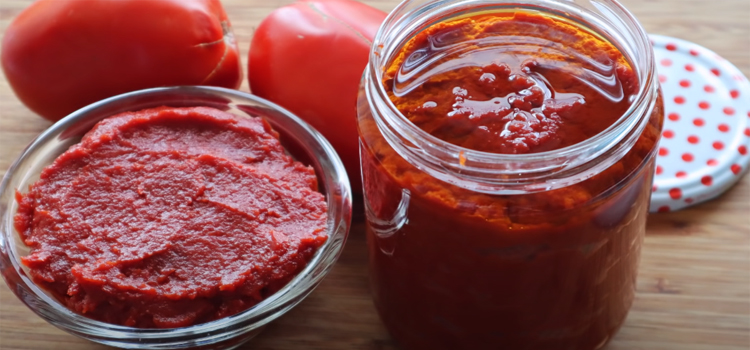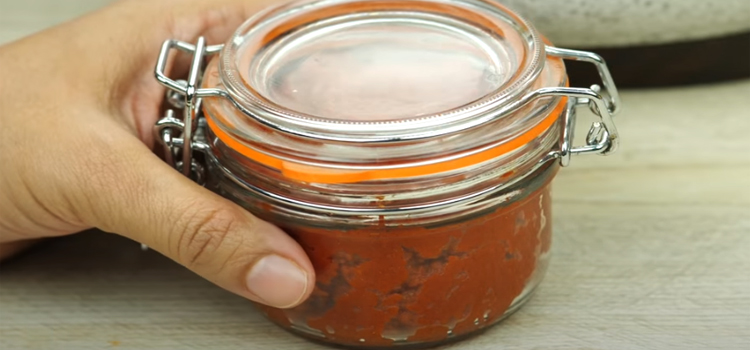Last Updated on September 13, 2024 by Shari Mason
Tomato paste **adds a burst of flavor** to every dish you try, jazzing up **soups**, **stews**, **sauces**, and **marinades** alike.
One convenient form of tomato paste is in a tube, making it easy to use small amounts at a time without opening a whole can. However, you may wonder how long tomato paste in a tube last once it is opened.
We will explore the shelf life of tomato paste in a tube, how to store it properly, and signs to look for to know when it has gone bad.
How Long Is Tomato Paste In A Tube Good For?


Tomato paste [1] in a tube is typically good for up to two months after it is opened and stored properly.
The key to keeping tomato paste in a tube fresh for as long as possible is to keep it in the refrigerator once it is opened and ensure the tube is tightly sealed when it is not in use.
When stored in the refrigerator, tomato paste in a tube can last up to six months after it is opened.
“Knowledge is knowing that a tomato is a fruit. Wisdom knows not to put it in a fruit salad.”
– Brian O’Driscoll, Irish Rugby Player
However, it is important to note that the shelf life of tomato paste can be affected by various factors, including the refrigerator’s temperature and how often the paste is exposed to air.
The paste can develop mold or spoil if it is not stored properly or stored for too long. To ensure the paste is still fresh, it’s important to check the paste for any discoloration or bad smell, as this is a sign of spoilage.
Read:
- Do Sun-Dried Tomatoes Need To Be Refrigerated?
- What Is Taco Bell Red Sauce?
- How To Make Store-Bought Spaghetti Sauce Better?
Can You Freeze Tomato Paste In A Tube?
Yes, you can freeze tomato paste in a tube. Freezing tomato paste effectively extends its shelf life and makes it more convenient. When freezing tomato paste, it is important to follow these steps:
- Squeeze the tomato paste out of the tube and into a sealable plastic bag or container.
- Remove as much air as possible from the bag or container to prevent freezer burn.
- Label the bag or container with the date and the amount of paste.
- Place the container or bag in the freezer.
When freezing tomato paste, it is important to use it within 12 months for the best quality. You can thaw the paste by placing the container in the refrigerator overnight or by placing the frozen paste in a bowl of warm water.
It is also important to note that tomato paste will not have the same texture as when it was first opened once thawed. It may have a more watery consistency and may not be good for some recipes, and it’s best to use it in cooked dishes.
Signs That Tomato Paste Might Have Gone Bad


- Off odor: If the paste has a sour or spoiled smell, it is likely that it has gone bad and should not be used.
- Discoloration: If the paste has turned brown or black, it is a sign that it has gone bad and should be discarded.
- Mold: If the paste has visible mold growth, it should be discarded immediately.
- Texture: If the paste is lumpy, slimy, or has a watery consistency, it is a sign that it is no longer fresh and should not be used.
- Taste: If the paste has a bitter or sour taste, it is a sign that it has gone bad and should not be used.
Tips On How To Store Tomato Paste In A Tube
- Please keep it in the refrigerator: Once the tube is opened, it should be stored in the refrigerator. The cool temperature will help to preserve the paste and slow down the growth of any bacteria that might be present.
- Seal the tube tightly: Make sure to tightly seal the tube after each use to keep air out, which can cause the paste to dry out and become less flavorful.
- Use a clean utensil: Use a clean utensil, such as a spoon or butter knife, to scoop out the paste to avoid introducing bacteria [2] into the paste.
- Don’t overbuy: Only buy as much tomato paste as you will use within the next six months, as the paste will lose its quality over time.
- Label the tube: Label the tube with the date of opening. This way, you can track how long the paste has been opened and use it before the expiration date.
- Use it in cooked dishes: Once opened, the paste will not be the same texture as when it was first opened. It may have a more watery consistency and may not be good for some recipes. It’s best to use it in cooked dishes.
FAQs
u003cstrongu003eHow long does unopened tomato paste in a tube last?u003c/strongu003e
Unopened tomato paste in a tube typically has a shelf life of about 1-2 years when stored in a cool, dry place. The exact shelf life of tomato paste in a tube can vary depending on the brand and the specific manufacturing process used.
u003cstrongu003eIs tube tomato paste better than canned?u003c/strongu003e
Tube tomato paste is more convenient to use as it is easy to dispense and allows you to use small amounts of paste at a time without opening a whole can. It is also less likely to get spoiled because of less exposure to air, which can cause the paste to dry out and become less flavorful.u003cbru003eu003cbru003eCanned tomato paste, on the other hand, is more widely available and is often less expensive. It also has a longer shelf life, as long as it is unopened, and once open, it can be stored in the refrigerator for a long time.
Key Takeaways
Tomato paste in a tube is a convenient and flavorful ingredient that can be used in various dishes. The shelf life of tomato paste in a tube can vary, but when stored properly in the refrigerator, it can last for up to six months after it is opened.
However, it is important to note that the shelf life can be affected by various factors, including temperature and how often the paste is exposed to air.
To ensure the paste is still fresh, it’s important to check the paste for any discoloration or bad smell, as this is a sign of spoilage.
Freezing tomato paste is also an option that can extend its shelf life, but it should be used within 12 months for the best quality. Always check the expiration date and follow the manufacturer’s instructions and recipe instructions for the best results.
References:
- https://www.thekitchn.com/how-to-make-tomato-paste-cooking-lessons-from-the-kitchn-206853
- https://www.britannica.com/science/bacteria
- Can You Put an AC Unit in the Kitchen? - September 27, 2024
- What Cheese Does Olive Garden Use? Discover Their Signature - September 27, 2024
- How to Cancel a Pizza Hut Order? Quick & Easy Guide - September 24, 2024


